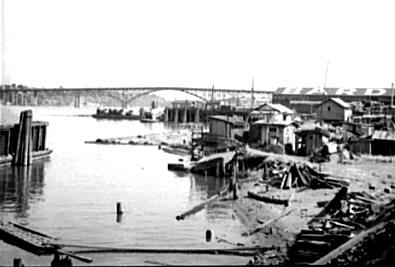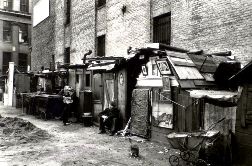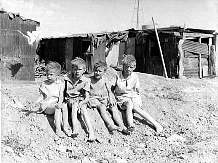|

A Great Depression Hooverville
(Shanty Town) near Portland, Oregon
|
Shanty Town Facts for kids: Fast Fact Sheet
Fast, fun facts and Frequently Asked Questions (FAQ's)
about the Shanty Town
for kids.
What were the Hoovervilles (Shanty Town) of
the Great Depression? Hoovervilles were
the nickname given to a Shanty Town during
the Great Depression and consisted of camps
of makeshift shacks or tents set up on
unused or public lands.
Who lived in a Hooverville or Shanty Town?
The people who lived in a Hooverville or
Shanty Town were men, women and children,
black and white, from all walks of life, who
had been evicted from their homes and made
homeless due to unemployment in the Great
Depression.
Why was the Shanty Town called a
Hooverville?
The Shanty Town was given the sarcastic
nickname 'Hooverville' after President
Herbert Hoover who Americans blamed for the
Great Depression
Shanty Town
Facts for kids
The following fact
sheet contains interesting facts and information on Shanty Town
and Hoovervilles.
Shanty Town
Facts (The Hoovervilles) for kids
Shanty Town Fact 1:
The Shanty Town
was not new to America. Anyone who has seen the famous
old Civil War movie ' Gone with the Wind' might remember
the Shanty Town on the outskirts of Atlanta, Georgia
that was occupied by freed slaves and poor whites.
Shanty Town Fact
2: During the Great
Depression of the 1930s there was Mass Unemployment in
America. Twelve million Americans, about 25% of the
normal labor force, were out of work and many suffered
poverty, deprivation and homelessness. Hoovervilles, or
shantytowns, became a common sight.
Shanty Town Fact 3:
The nickname 'Hooverville' was
given to the shanty towns that sprang up across the nation during
the Great Depression. The name was a reference to Herbert Hoover who
was the President of the United States during the at the start of
the Depression and widely blamed for it.
Shanty Town Fact 4:
Where were Hoovervilles
situated? The answer to this question is practically anywhere. The
large camps were set up on the worst type of unused or public land
often on the outskirts of towns and cities. Many were established
near rivers, as the above picture shows, or ponds - it helped to
have access to some water.
Small camps and sites in towns
sprang up in any available space. The picture opposite shows a small
site in Manhattan, New York.

Shanty Town Fact 5:
How many Hoovervilles or
Shantytowns were there? No one knows, but there were literally
millions of homeless people during the Great Depression so it seems
reasonable to estimate the number as several thousands. Some have
estimated that 500 Hoovervilles sprang up in 1929 and increased in
number to over 6000 in the 1930s.
Shanty Town Fact 6:
What were the
rickety shacks in Hoovervilles and Shantytowns built
with? Absolutely anything that would provide shelter.
Odd pieces of wood, stones, loose boards, crates,
cardboard, scraps of other materials, old bricks and
parts of boxes,
Shanty Town Fact 7:
Reasons for
Homelessness: Homeowners lost their houses when they
could not pay mortgages or pay taxes. People who rented
their homes fell behind with the rent and were evicted
by bailiffs.
Shanty Town Fact 8:
How many people
lived in the Hoovervilles in the 1930s? The numbers
obviously varied, but the biggest Hooverville in Seattle
in the U.S. state of Washington served as the home to
1200 people. The shanty town was so big that people
established their own community government and elected a
'mayor' as their leader to settle any disputes. The
Seattle Hooverville covered nine acres of land on the
tidal flats adjacent to the Port of Seattle. Seattle was
also the location of seven other shantytowns.
Shanty Town Fact
9: Hoovervilles were racially
integrated. Black and white Americans and immigrants
from all over the world shared the camp sites. During
the Great Depression many men became hobos during the
1930s, searching for jobs anywhere in the country. The
easiest way to travel across the country was by train
and Shantytowns, nicknamed 'Hobo Jungles' sprang up by
most city railroad stations.
Shanty Town Fact
10: As the Great
Depression deepened people protested and launched hunger
marches. WW1 veterans formed what was called the
Bonus Army and 40,000
people descended on Washington
D.C. and set up makeshift camps on areas such as the Anacostia Flats.
Shanty Town Fact 11:
Homeless people
were forced to live in absolute poverty in the
Hoovervilles or shantytowns in the 1930s.
● The Floors of
the shacks were
often made of dirt, clay or mud
● Access to safe
drinking water was limited and only available from
ponds and rivers
● The sanitation facilities
were totally inadequate - latrines were dug
in ditches
● Tents and
makeshift shacks provided inadequate shelter during
inclement weather conditions

Shanty Town Fact 12:
People who lived in Hoovervilles did not have
access to medical facilities and the living conditions in the shanty
towns bred sickness and disease. In cities people lived wherever
they could find shelter under bridges, on subways and in public
parks. Americans in rural areas made homes in caves. During the
winter months people even asked to sleep in jail cells.
Continued...
Shanty Town
Facts (The Hoovervilles) for kids
Facts
about the Shanty Town for kids:
Hoovervilles
The following fact
sheet continues with facts about the Shanty Town and
Hoovervilles for kids.
Shanty Town
Facts (The Hoovervilles) for kids
Shanty Town Fact 13:
Inhabitants living in the
primitive conditions of the shantytowns were subject to many health
problems. Inadequate sanitation, lack of clean drinking water and
poor nutrition lead to a variety of diseases and illnesses such as
tuberculosis, diphtheria, diarrhea, rickets, influenza, pneumonia
and skin diseases.
Shanty Town Fact 14:
The state
described as
'absolute poverty' has been described as "a condition
characterized by severe deprivation of basic human
needs, including food, safe drinking water, sanitation
facilities, health, shelter, education and information".
The inhabitants of the Hoovervilles and shantytowns in
the 1930s were deprived of many of these basic needs -
for additional facts refer to
Poverty in the
Great Depression
Shanty Town Fact 15:
New York City saw
the emergence of many Hoovervilles during the 1930s:
● Homeless people set up camp
at an empty reservoir - now the Great Lawn at
Central Park. It was called "Hoover Valley" and the
shacks were referred to as "Depression Street". It
was demolished in April 1933 when work on the
reservoir landfill resumed
● Other shantytowns in New York
were given their own names:
● ● "Hardlucksville" was at
the end of 10th Street on the East River
● ● “Camp Thomas Paine” was
set up along the Hudson in Riverside Park
● Red Hook, a neighborhood in
Brooklyn, New York City also had its own shantytown
Shanty Town Fact 16:
During the Great Depression
of the 1930s author
John Steinbeck wrote "The Grapes of Wrath" about the lives of the people living in the
Prairies states and the devastating effects of the Dust
Bowl. In his famous novel the Joad family briefly
settles into a Hooverville in California. In "The Grapes
of Wrath" the camp is described as filthy, filled with
hopeless, despairing residents. There was no work,
people were starving and the local police repeatedly
burned down the camp.
Shanty Town Fact 17:
Many authorities
frequently tolerated the shantytowns out of sheer
necessity. Others responded to complaints by people in
the neighborhood and evicted the inhabitants and burned
the shacks.
Shanty Town Fact 18:
The Great
Depression drew to an end with the outbreak of WW2 and
municipal programs aimed at "eradicating" shantytowns
destroyed all the Hoovervilles.
Shanty Town
Facts (The Hoovervilles) for kids
Shanty Town
Facts (The Hoovervilles)
for kids
For visitors interested in the history of
the Great Depression refer to the following articles:
Shanty Town Facts for kids: Hoovervilles - President Herbert Hoover Video
The article on the Shanty Town provides detailed facts and a summary of one of the important events during his presidential term in office. The following
Herbert Hoover video will
give you additional important facts and dates about the political events experienced by the 31st American President whose presidency spanned from March 4, 1929 to March 4, 1933.
Shanty Town Facts: Hoovervilles
●
Interesting Shanty Town Facts for kids and schools
●
Summary of the Shanty Town in US history
●
Shanty Town facts and Hoovervilles a major
event in US history
●
Hooverville and Shanty Town Facts
●
Fast, fun facts about the Shanty Town
●
Foreign & Domestic
policies of President Herbert Hoover
●
Herbert Hoover Presidency and
Hoovervilles and Shanty Town Factsfor schools,
homework, kids and children |